weight TOYOTA SIENNA 2020 Warranties & Maintenance Guides (in English)
[x] Cancel search | Manufacturer: TOYOTA, Model Year: 2020, Model line: SIENNA, Model: TOYOTA SIENNA 2020Pages: 260, PDF Size: 8.54 MB
Page 136 of 260
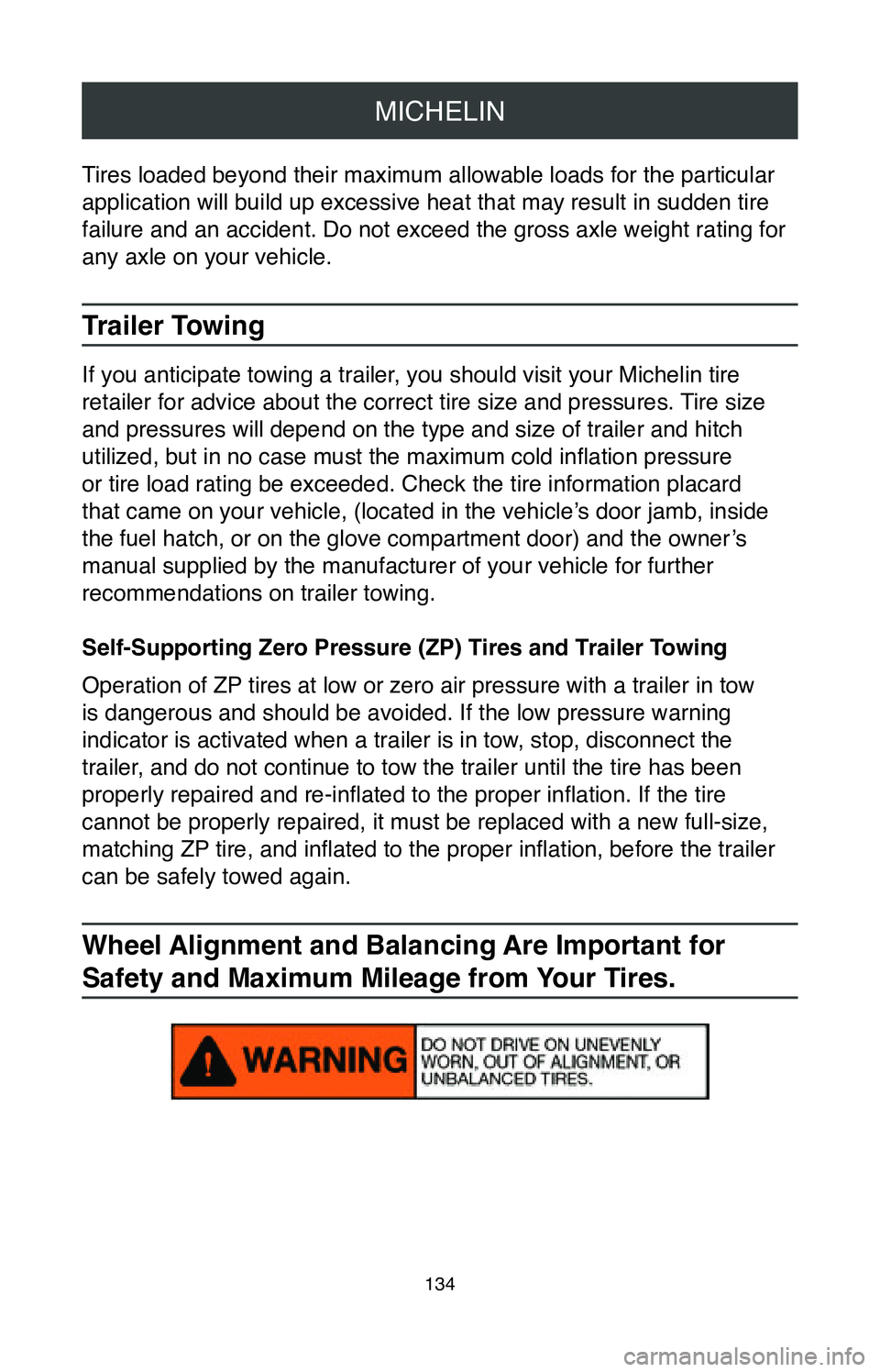
MICHELIN
134
Tires loaded beyond their maximum allowable loads for the particular
application will build up excessive heat that may result in sudden tire \
failure and an accident. Do not exceed the gross axle weight rating for \
any axle on your vehicle.
Trailer Towing
If you anticipate towing a trailer, you should visit your Michelin tire
retailer for advice about the correct tire size and pressures. Tire size
and pressures will depend on the type and size of trailer and hitch
utilized, but in no case must the maximum cold inflation pressure
or tire load rating be exceeded. Check the tire information placard
that came on your vehicle, (located in the vehicle’s door jamb, inside
the fuel hatch, or on the glove compartment door) and the owner’s
manual supplied by the manufacturer of your vehicle for further
recommendations on trailer towing.
Self-Supporting Zero Pressure (ZP) Tires and Trailer Towing
Operation of ZP tires at low or zero air pressure with a trailer in tow
is dangerous and should be avoided. If the low pressure warning
indicator is activated when a trailer is in tow, stop, disconnect the
trailer, and do not continue to tow the trailer until the tire has been
properly repaired and re-inflated to the proper inflation. If the tire
cannot be properly repaired, it must be replaced with a new full-size,
matching ZP tire, and inflated to the proper inflation, before the trailer
can be safely towed again.
Wheel Alignment and Balancing Are Important for
Safety and Maximum Mileage from Your Tires.
Page 140 of 260
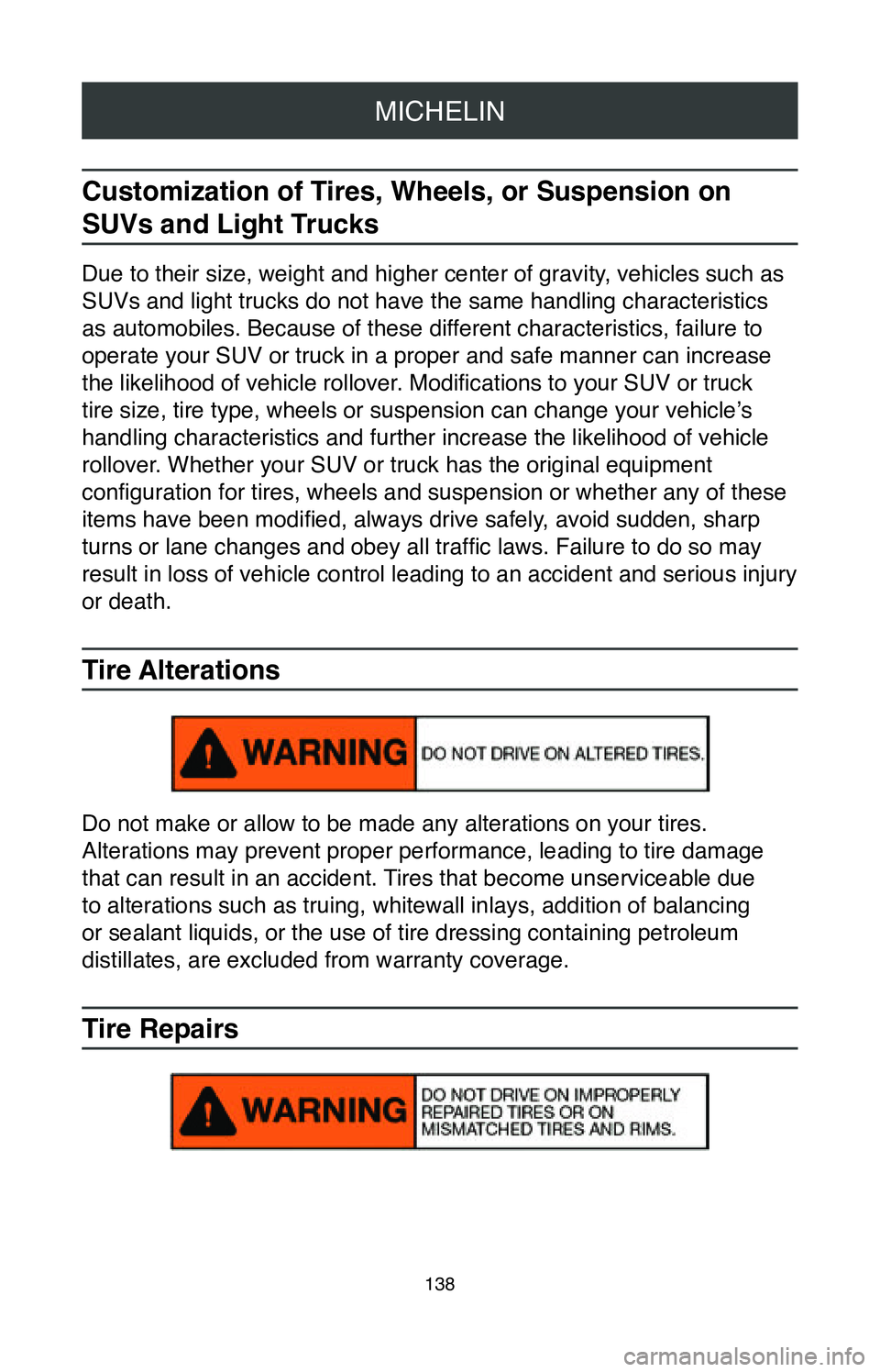
MICHELIN
138
Customization of Tires, Wheels, or Suspension on
SUVs and Light Trucks
Due to their size, weight and higher center of gravity, vehicles such as
SUVs and light trucks do not have the same handling characteristics
as automobiles. Because of these different characteristics, failure to
operate your SUV or truck in a proper and safe manner can increase
the likelihood of vehicle rollover. Modifications to your SUV or truck
tire size, tire type, wheels or suspension can change your vehicle’s
handling characteristics and further increase the likelihood of vehicle \
rollover. Whether your SUV or truck has the original equipment
configuration for tires, wheels and suspension or whether any of these
items have been modified, always drive safely, avoid sudden, sharp
turns or lane changes and obey all traffic laws. Failure to do so may
result in loss of vehicle control leading to an accident and serious injury
or death.
Tire Alterations
Do not make or allow to be made any alterations on your tires.
Alterations may prevent proper performance, leading to tire damage
that can result in an accident. Tires that become unserviceable due
to alterations such as truing, whitewall inlays, addition of balancing
or sealant liquids, or the use of tire dressing containing petroleum
distillates, are excluded from warranty coverage.
Tire Repairs
Page 141 of 260
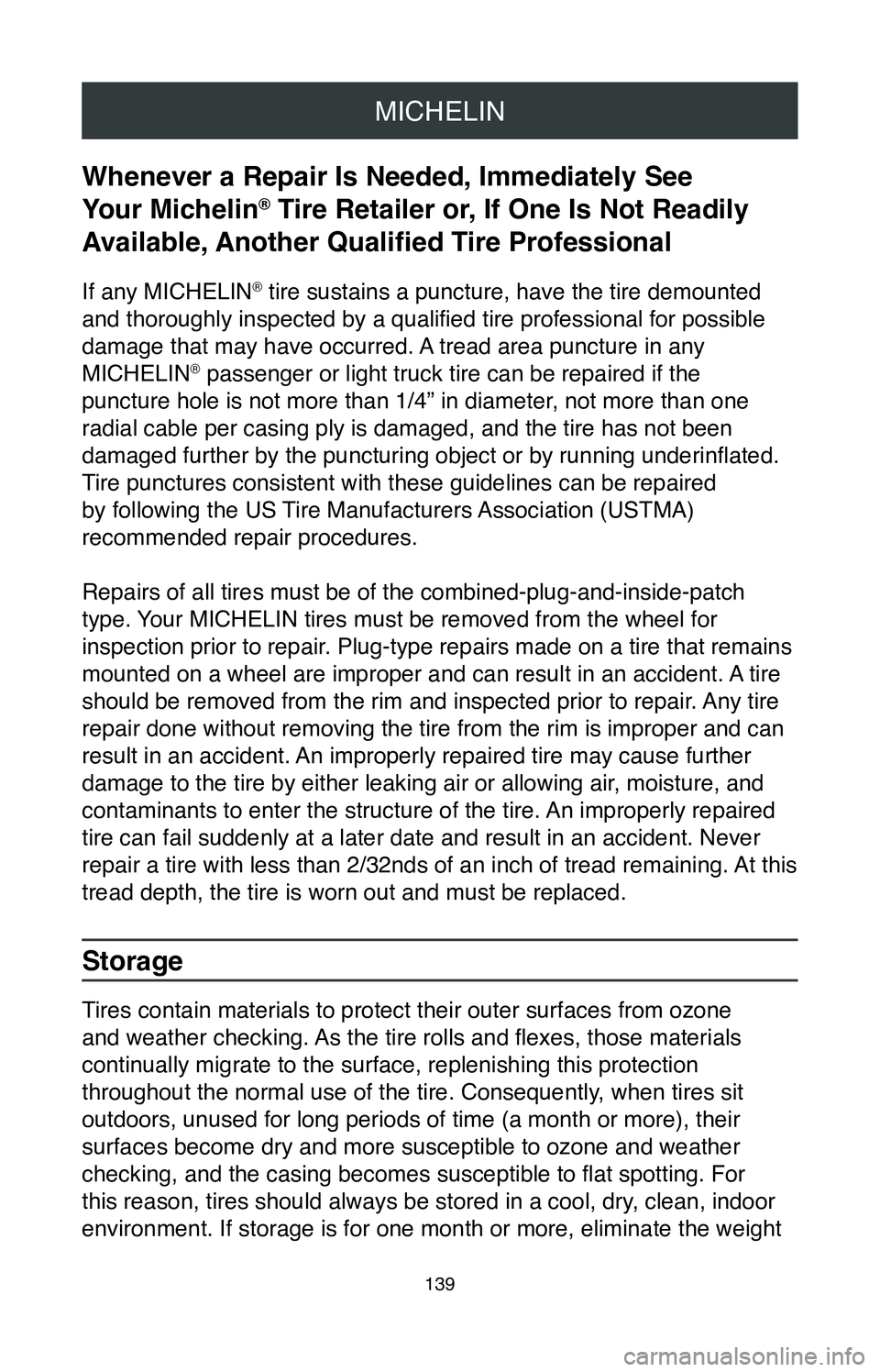
MICHELIN
139
Whenever a Repair Is Needed, Immediately See
Your Michelin
® Tire Retailer or, If One Is Not Readily
Available, Another Qualified Tire Professional
If any MICHELIN® tire sustains a puncture, have the tire demounted
and thoroughly inspected by a qualified tire professional for possible
damage that may have occurred. A tread area puncture in any
MICHELIN
® passenger or light truck tire can be repaired if the
puncture hole is not more than 1/4” in diameter, not more than one
radial cable per casing ply is damaged, and the tire has not been
damaged further by the puncturing object or by running underinflated.
Tire punctures consistent with these guidelines can be repaired
by following the US Tire Manufacturers Association (USTMA)
recommended repair procedures.
Repairs of all tires must be of the combined-plug-and-inside-patch
type. Your MICHELIN tires must be removed from the wheel for
inspection prior to repair. Plug-type repairs made on a tire that remains
mounted on a wheel are improper and can result in an accident. A tire
should be removed from the rim and inspected prior to repair. Any tire
repair done without removing the tire from the rim is improper and can
result in an accident. An improperly repaired tire may cause further
damage to the tire by either leaking air or allowing air, moisture, and
contaminants to enter the structure of the tire. An improperly repaired
tire can fail suddenly at a later date and result in an accident. Never \
repair a tire with less than 2/32nds of an inch of tread remaining. At this
tread depth, the tire is worn out and must be replaced.
Storage
Tires contain materials to protect their outer surfaces from ozone
and weather checking. As the tire rolls and flexes, those materials
continually migrate to the surface, replenishing this protection
throughout the normal use of the tire. Consequently, when tires sit
outdoors, unused for long periods of time (a month or more), their
surfaces become dry and more susceptible to ozone and weather
checking, and the casing becomes susceptible to flat spotting. For
this reason, tires should always be stored in a cool, dry, clean, indoor
environment. If storage is for one month or more, eliminate the weight
Page 158 of 260
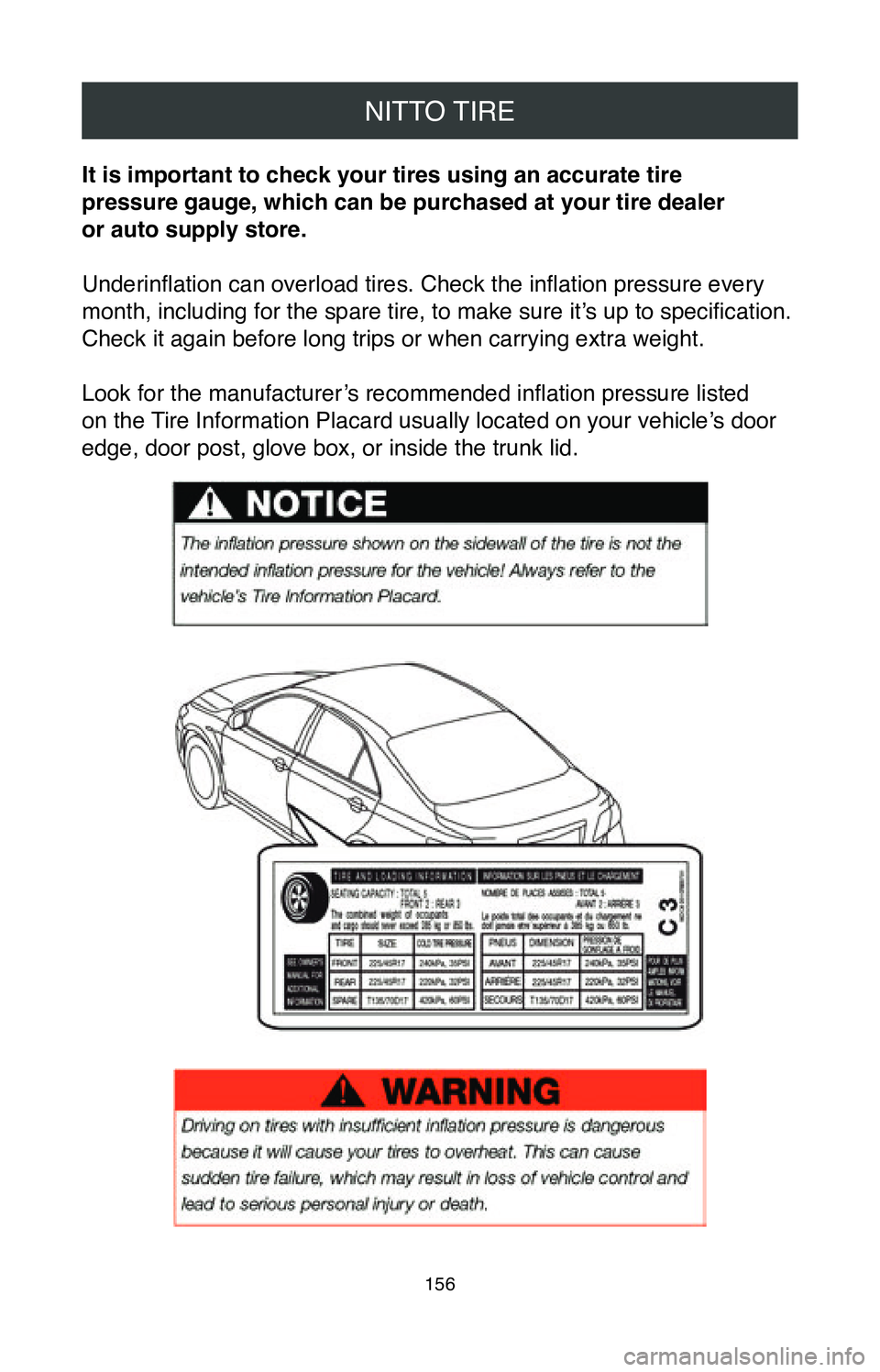
NITTO TIRE
156
It is important to check your tires using an accurate tire
pressure gauge, which can be purchased at your tire dealer
or auto supply store.
Underinflation can overload tires. Check the inflation pressure every
month, including for the spare tire, to make sure it’s up to specification.
Check it again before long trips or when carrying extra weight.
Look for the manufacturer’s recommended inflation pressure listed
on the Tire Information Placard usually located on your vehicle’s door
edge, door post, glove box, or inside the trunk lid.
Page 217 of 260
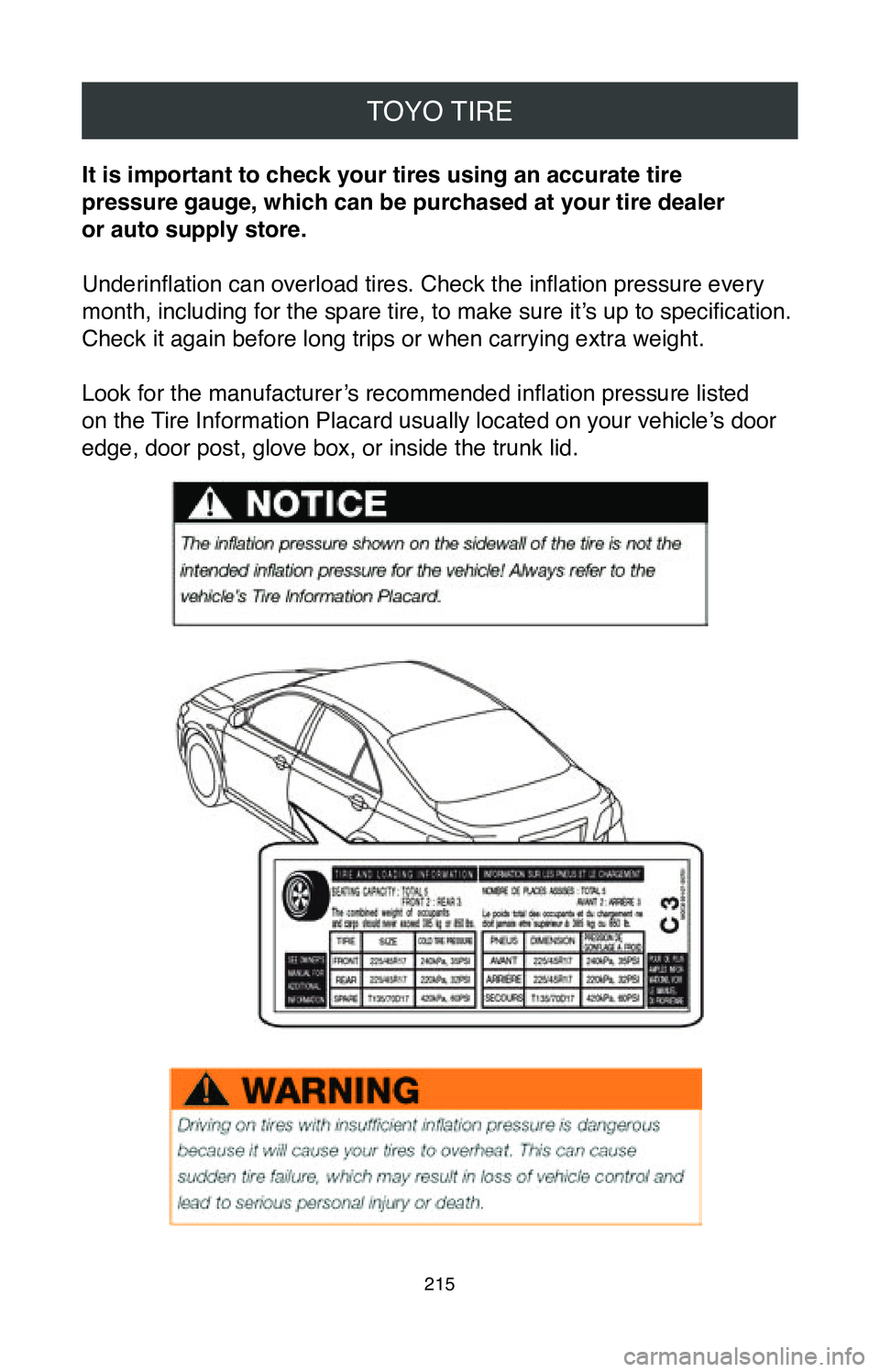
TOYO TIRE
215
It is important to check your tires using an accurate tire
pressure gauge, which can be purchased at your tire dealer
or auto supply store.
Underinflation can overload tires. Check the inflation pressure every
month, including for the spare tire, to make sure it’s up to specification.
Check it again before long trips or when carrying extra weight.
Look for the manufacturer’s recommended inflation pressure listed
on the Tire Information Placard usually located on your vehicle’s door
edge, door post, glove box, or inside the trunk lid.